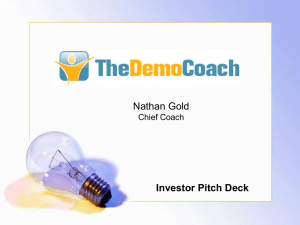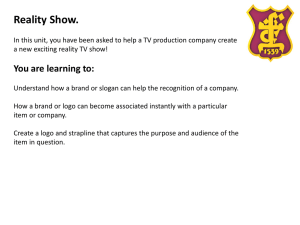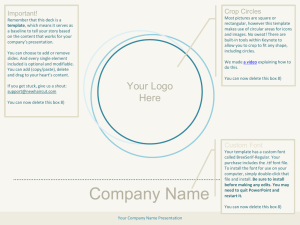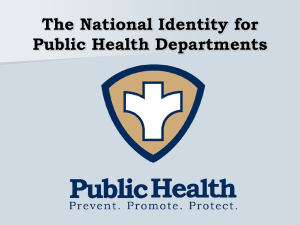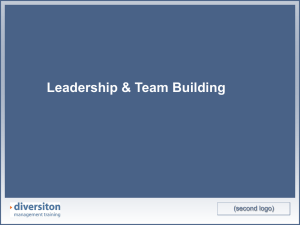Seminar Delivered On Innovation for Conference
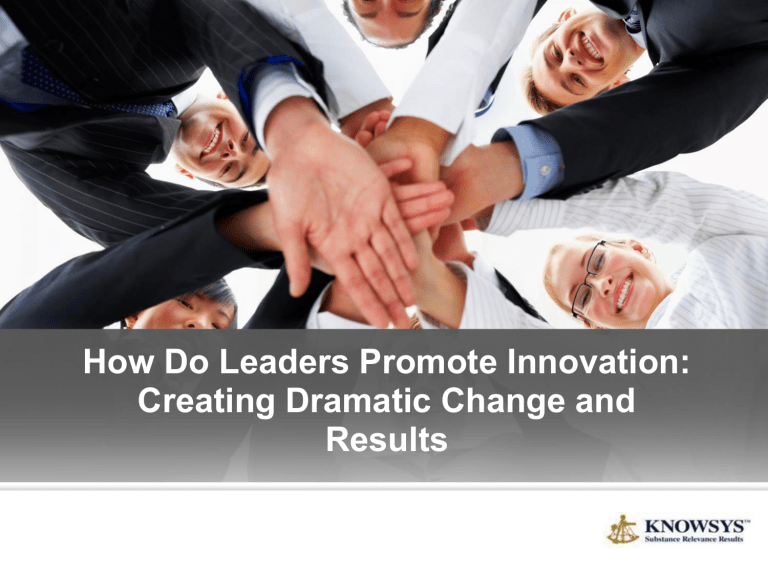
How Do Leaders Promote Innovation:
Creating Dramatic Change and
Results
Enter your subtitle or main author ‘s name here
Innovation
Agenda
What we plan on covering today:
3
4
1
2
Defining Innovation
Public Sector Innovation-Examples and Lessons Learned
Private Sector Innovation-Examples and Lessons Learned
Building Blocks for Creating Innovation:
• Talent Management
• Governance
• Financial Management Changes Required
• Leveraging Technology to create Innovation
• Process Transformation
• Cultural Change: Creating Collaboration and Intrapreneurship
5
Page 2
How do we implement these great ideas?
YOUR LOGO
Defining Innovation -Creating a Common
Understanding for Our Discussion
What Innovation Is…
Innovation is accomplished through more effective products, processes, services, technologies , or ideas that are readily available to markets, governments, and society.
Innovation differs from invention in that innovation refers to the use of a better and, as a result, novel idea or method , whereas invention refers more directly to the creation of the idea or method itself. Innovation differs from improvement in that innovation refers to the notion of doing something different rather than doing the same thing better. (Wikipedia)
What Innovation is Not…
Common causes of failure within the innovation process in most organizations can be distilled into five types: Poor goal definition , Poor alignment of actions to goals , Poor participation in teams, Poor monitoring of results, Poor communication and access to information (O'Sullivan, David (2002). "Framework for Managing Development in the
Networked Organisations". Journal of Computers in Industry).
YOUR LOGO
Page 3
Public Sector Innovation-Examples and Lessons Learned
The Self-Funding Model
The self-funded portal model essentially eliminates the financial risks governments would have to undertake by transferring the up-front capital investment to a private sector partner.
The public sector organization then charges transaction fees on a small number of services to fund the operation of the overall portal. These fees cover the cost of paying the private sector partner for the initial investment as well as ongoing maintenance, upgrades and development of new self-service solutions.
Example: Texas
In 2010, Texas gov ’t securely processed 22 million digital transactions valued at more than $4 billion. Its portal offers more than 1,000 online services and provides e-government solutions to 178 state and local agencies. It was developed and managed at zero cost to Texas through the self-funded approach.
Lessons Learned:
• Embrace the public-private partnership
• Have a plan and expect to mature over time
• Understand the paradigm and look at your portal as a service delivery platform and not an information center
YOUR LOGO
Page 4
Public Sector Innovation-Examples and Lessons Learned
“Big Data” - Obama’s competitive advantage in winning the U.S. Presidency
After the voters returned Obama to office for a second term, his campaign became celebrated for its use of technology —much of it developed by an unusual team of coders and engineers — that redefined how individuals could use the Web, social media, and smartphones to participate in the political process.
Dan Wagner, the chief analytics officer for Obama 2012, led the campaign ’s
“Cave” of data scientists.
A mobile app allowed a canvasser to download and return walk sheets without ever entering a campaign office; a Web platform called Dashboard gamified volunteer activity by ranking the most active supporters; and “targeted sharing” protocols mined an Obama backer ’s Facebook network in search of friends the campaign wanted to register, mobilize, or persuade.
But underneath all that were scores describing particular voters: a new political currency that predicted the behavior of individual humans. The campaign didn ’t just know who you were; it knew exactly how it could turn you into the type of person it wanted you to be. (MIT Technology Review December
2012)
Lesson Learned: “My kingdom for a horse”, King Richard III
“My presidency for Big Data”, Mitt Romney, 2012
YOUR LOGO
Page 5
Public Sector Innovation-Examples and Lessons Learned
Booker at the 2011 Time 100 Gala
Cory Booker, Mayor of Newark-Innovation via Leadership
In 2008, Newark had its lowest murder rate since 1959. March 2010 marked Newark ’s first murder-free month in over 44 years. As of April 1,
2010, the murder rate in Newark was the second best since 1941, and crime rates for aggravated assaults, robberies, carjacking, and shootings were also down for the first quarter compared to 2009.
In addition to his crime-lowering initiatives, Booker both doubled the amount of affordable housing under development and quadrupled the amount under pre-development, and reduced the city budget deficit from
$180 million to $73 million.
( Time Magazine July 2009)
Mark Zuckerberg Donation
In July 2010, Booker attended a dinner at a conference in Sun Valley,
Idaho where he was seated with Mark Zuckerberg. Zuckerberg, who had no known ties to Newark, announced in September 2010 that he was donating $100 million of his personal fortune to the Newark school system.
Lessons Learned: Leading by example creates an organizational culture that can create miracles with virtually no resources, using social consciousness as fuel.
YOUR LOGO
Page 6
Top 10 Innovative Companies for 2013 (Fast Company)
1.
Nike- For a pair of revolutionary ideas and a culture of true believers.
6 . Uber-fuses tech with cabs
2. Amazon-Speeding up the delivery of change
7. Sproxil-busting manufacturers selling fraudulent ingestible goods.
3. Square-a simple idea--enable credit card transactions on mobile devices
8. Pinterest-social scrapbooking site was dubbed the fastest-growing web service in history .
4. Splunk-For Bringing Big Data to the masses
5. Fab-online boutiques of design-centric products for such niches as foodies and pet lovers.
9. Safaricom-In Kenya, where more than half of citizens live on less than a dollar a day, medical care can be a far-off luxury. But local telecom giant Safaricom has built a vital bridge between doctor and patient. It launched Daktari 1525 in late 2011, a 24/7 call-in service that, for a small fee, connects callers one-onone with a doctor.
10. Target-shrinking the big box, going local, leveraging mobile services to provide personal service
YOUR LOGO
Page 7
Private Sector Innovation-Examples and Lessons Learned
Page 8
The most successful companies encourage innovation in the workplace.
For example, Google allows their staff to spend 30% of their time pursuing their own creative interests which has lead to innovative ideas such as
Google Maps and Google Adsense, which have genuinely changed the way we live and made Google in phenomenon more than a search engine.
Lesson learned: giving time to employees to be creative can result in bottom-line benefits like new products or services.
YOUR LOGO
Private Sector Innovation-Examples and Lessons Learned
Page 9
Innovation for funding a data-mining competition to reduce unnecessary hospital visits. It ’s the Netflix Prize for health care.
Just as Netflix spurred the development of a more accurate predictor of movie preferences, Heritage is out to spark the creation of an algorithm that analyzes historical patient data and predicts how many days someone winds up in a hospital in a year.
Based on that information, health-care providers can work backwards, trying to prevent medical emergencies. The grand prize is $3 million for the winning team, but the benefit of reducing hospital stays could be in the billions.
Lesson Learned: These are capabilities that Canada ‘s Health Care
System could dramatically benefit from
YOUR LOGO
Private Sector Innovation-Examples and Lessons Learned
Page 10
For designing an online coaching platform to help vets graduate.
An online community and platform that coaches veterans through the process of preparing for college and the workforce,
Fidelis provides technological solutions (gamification, badges) to the tough problem of student retention for a demographic that struggles in the transition back to school and work. Fidelis will serve as virtual counselors for vets, from GED tests through their first jobs. They ’re in discussions with
Harvard University, Stanford University, and the Massachusetts Institute of
Technology, among others.
Lesson Learned: Gaming, On-line Learning, and Social Media combined can retrain and re-educate supposedly “untrainable” citizens at a nominal cost.
YOUR LOGO
Building Blocks for Creating Innovation
Talent
Management
How you hire, who you hire, how you motivate people , how do you create and propogate intellectual capital
Page 11
Clearly defined goals, Actions in line with goals, organizational structure/business model supporting results, Results and the ability to measure them
Governance
Financial
Management
Clearly Defined
Perfomance
Measurements,
New paradigms for funding investment based on new business models,
Flexibility with respect to compensating based on results
Opportunities are endless to leverage technology to create innovative products, services, reduction in cost or cycle time improvements
Lead by Example,
Create a
Corporate Social
Consciousness
Reward
Collaboration and
Entrepreneurial
Behaviour
Recognize
Results
Technology
Process
Transformation
Collaboration and
Intrapreneurship
Obliterate nonvalue-add, redundant, and duplicative work
Look at speeding up
“cycle” time from a customer perspective and cross-functional scope YOUR LOGO
How do we implement these great ideas?
Think Big, Start Small to create sustainable innovation…………..
Start with the end in mind.
Strategy drives goals, structure, funding, behaviour, and results.
Eliminate manual processing unless it represents unique intellectual capital.
Question everything….
Without well-defined strategy and governance and all of the underlying building blocks in alignment, success is not possible.
Create clear-cut baselines and then show measurable results
Mobile Technology and Big
Data are two of the most important innovations and yet they are under-utilized by private and public sector organizations.
Technology can reconfigure how, when, where, and even why you deliver your business.
Page 12
This is the most difficult and important piece of the puzzle. If you get it right, you can create miracles.
YOUR LOGO
The Case for Improved Collaboration -- Findings
Findings and conclusions:
We do not know what we know…
…or even what we do not know
Many are still stuck in email and face to face meetings
Less that one third feel they have the right tools
Processes are a bigger challenge than the tools
Remote and multi-location teams are here to stay
With improved Collaboration :
To improve
Collaboration…..
……we must:
•Share more
•Ask more often
•Make more information available
•Search more often
•Communicate more often
•…..especially in groups
Better decisions and solutions, faster
Higher employee engagement
Higher productivity and efficiency
Lower costs and higher returns
YOUR LOGO
Page 13
Path Toward Improved Innovation /
Collaboration
Assessment of Current Status:
Processes
Strengths and Weaknesses
Available Tools and use thereof
Develop vision of desired state
Develop plan based on Pilot teams
Implementation
Measure, evaluate & adjust
Page 14
YOUR LOGO
A Suggested Approach to Implementing Innovation in your
Organization
Think Big….Start Small
1.
Set-up an Innovation Office and appoint an Innovation Lead/Officer (depending on scope (line of business vs. enterprise).
2.
Create a charter-strategy, objectives, scope, performance measures. Build a plan of implementation and make the Innovation Lead accountable for it.
3.
Get some seed money approved-this will be used to do ground work/research which will feed subsequent business cases.
4.
Pinpoint key opportunities and prepare supporting business cases to get funding.
5.
Create an inter-disciplinary Advisory Steering Committee/Board comprised of Human
Resources, Finance, Marketing, Sales, Customer Service/Channels, and IT.
6.
Start educating people on what innovation means to your organization and tie it back into your business strategy. Hold lunch and learn sessions, brainstorming sessions, and formal training in innovation.
7.
Start thinking about intrinsic/extrinsic reward systems that can be implemented quickly for innovative thinking and action.
8.
Measure and track the benefits of innovative thinking/behaviour and determine a plan to propogate/replicate these successes in other areas.
YOUR LOGO
Page 15

